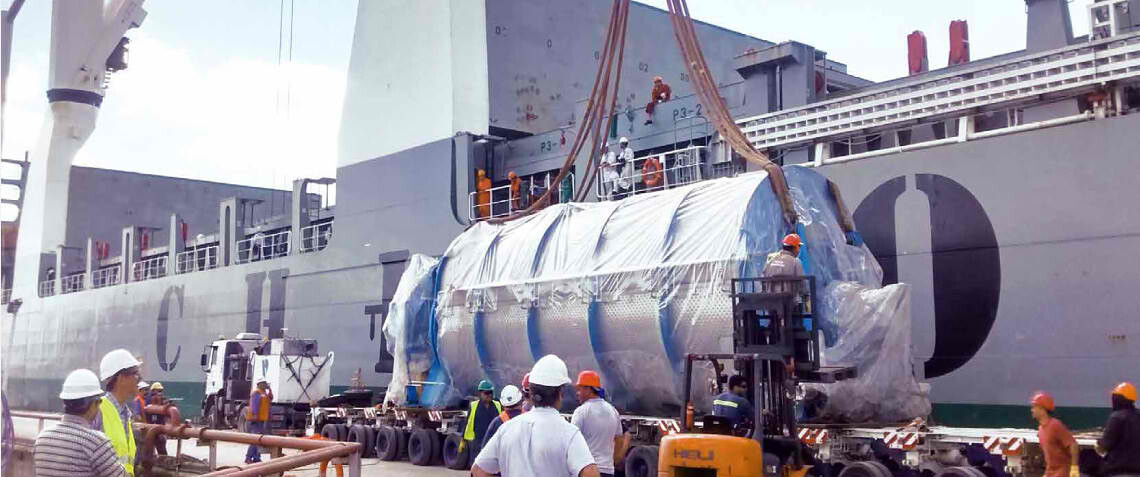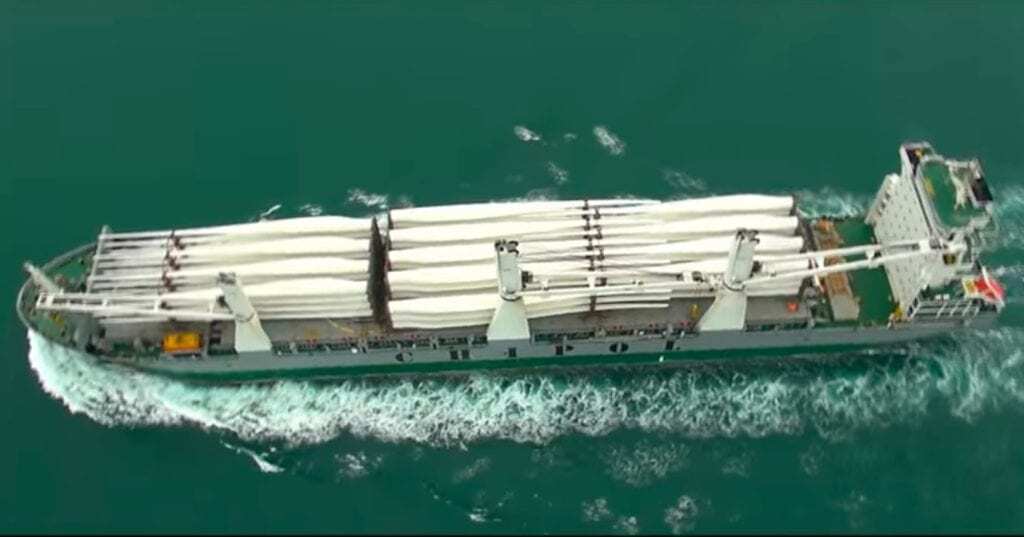Mr. Tjeerd Veldhuizen
Director
Tell us about when SeaWorks was established, who the owners are and where your office(s) are located.
SeaWorks was established in January 2013 by Stefan Pompe and Tjeerd Veldhuizen, former directors of Intermarine LLC and previously owners of Trinitas BV. Basically, SeaWorks is the continuation of Trinitas BV where Stefan Pompe and Tjeerd Veldhuizen had built up a vast service network, especially to South America. SeaWorks’ HQ is in the Netherlands with an offices in Santos and Antwerp. We also have partnerships in Hamburg, Buenos Aires and Montevideo.
Can you describe your breakbulk service to South America? Tell us a bit about the type of ships you have in the service and the ports of call.
One way we offer smart solutions for breakbulk and project cargo is by combining the cargoes so that various smaller part-cargoes can be shipped by one ship at a competitive ocean freight rate. At the moment we are generally using multi-purpose (MPP) ships of about 12,500tdwat with cranes of 80mts lifting capacity, combinable up to 160mts. With these ships we can basically call any port in Europe or the Baltic and Mediterranean Seas.
The market at the moment, to East Coast South America is very demanding. As many readers will know, Brazil is going through one of the most severe crises of the last decade, causing a decline in spendable budgets for projects. Consequently, the number of bigger projects fueling regular shipments has become less. Combining the various cargoes is therefore a careful operation which has to be stemmed with all parties involved. This is also caused by the type of cargo and where it is produced. For instance there are paper factory parts to be loaded in Finland but also steel which come out of Antwerp as well as Bilbao. Other cargoes will come from Germany, where mostly Hamburg is involved or from Norway, where we call Stavanger, but also smaller ports like Hordvikneset.
Basically, nowadays, we indicate the area where we shall load so that clients/shippers have an idea where our ships are able to serve them, then we fine-tune the ships’ rotation to the demands of the clients/shippers and call the ports where their product is exported.

Tell us about the heaviest pieces that you have carried. Do you accept containers and if so do you provide line’s equipment or only shippers own?
Well, lately we have carried industrial reels of which the heaviest pieces were around 250mtons. But this was cargo loaded and discharged by shore cranes. Our specialty and service consisted of having the right ship with the right stow-solution in a safe manner. Our ships, presently, are limited to max 160mtons lifting capacity and most of the cargo for East Coast South America are max 100-120mtons units. Of course, if there are heavier pieces involved, exceeding our 160mtons lifting capacity, we inform our clients accordingly. It makes little sense to give out a number without having the ship capable of lifting the weights.
The second part of your question, whether containers are accepted, we can reply; yes. However, these units are usually Shippers Owned Containers (SOC’s). In the past we have provided containers but that was in cooperation with the client for a large project. Usually we do not provide containers ourselves.

Tell us something about the projects that you have handled.
How much time do you have? Really, we have seen almost any cargo pass by which MPP ships can handle with gear of 80mts/160mts. Lately we have shipped a number of big industrial reels with flexible oil-pipes from the UK to Brazil. Another remarkable project was the shipment of special aluminum covers to the Amazon where the units were to be installed on local barges. That was a real example of our tailor-made and smart solution way of working. These covers were packed ashore and shipped by barge which was, for the shipper, the proof that the cargo could be shipped by a ‘boat’. However, the packing was not thought of for the forces at sea. During delivery by barges we had our port captain on the spot to take the dimensions, exactly, of each package so that we could work out the stowage plan. When he saw the way the cargo was packed, we took immediate action and arranged that the packaging was adapted for safe ocean transportation, whereby we had cut up some of the packaging in order to achieve staunch and seaworthy stowage. Initially the client did not agree, but when the handling was underway and ultimately the cargo was delivered in Brazil without any damage, he was very happy with the service rendered.
Our ultimate goal is for our clients to be satisfied with our service and return to us for the next shipment. This contains an important lesson, namely that what is planned ashore and fabricated does not always work for ocean transportation, therefore all parties should not to wait until the last moment to invite the shipping line into the equation. The shipping line should be invited into the project as early as possible and be engaged in the thinking to come to the best result.

How did you decide on the name SeaWorks for the company name?
Ahh, that’s a nice question. Well, basically Stefan and I sat together, in the months prior to January 2013, brainstorming how we would kickstart our operation. You know, we had almost one year ‘gardening leave’ from Intermarine times and had a pleasant time-off but realized that we had to move on again. We could not, at that moment, use the name ‘Trinitas’ so we thought of how we could come up with a ‘catchy’ name that has to do with the “sea” and “working” with cargoes/projects. We wrote a number of names on a white-board and every day we sat in front of it until we were down to 3 names. Then we put it in front of a number of people, SeaWorks was the name that people agreed with most.
Tell us about yourself Tjeerd. What made you become a “shipping man”?
This goes back some time, basically after graduation I was drafted into the army for military service. Initially I planned to serve with the Navy but due to cost-cuttings this all was changed and I ended up serving ashore and later in Germany, for almost 1.5years. After military service there was a 9 month gap until College, in the meantime I had to earn a living. At first I started in the accounting department of a construction company but soon found that it was not something I could do, even for 9 months, it was too dry. Then I applied to an advert for an assistant-broker with Spliethoff in Amsterdam and was hired.
Instead of entering maritime college that September I decided to continue with the job because the work really interested me and I could some money for my studies the following year. However, that went differently because a year later I was asked if I would like to take up post as a representative in Helsinki, to which I said yes. After Helsinki I moved to Gothenburg, Sweden.
After this time abroad, I returned to Amsterdam, with Spliethoff, where I was thoroughly trained in shipping. One day, I was offered an interesting position with a new company, NEPA in Amsterdam, where I worked for 3 years. I left NEPA when I was offered the position of partner in a ship operator in Rotterdam, Trinitas.
In 1997 after only 3.5 years in Rotterdam I was in the position to acquire Trinitas from the other partners with offices in Sao Paulo, Antwerp, Hamburg and Santos. In the year 2000 Trinitas and Intermarine entered into a joint venture which continued until 2010 when the activities of Trinitas as well as all it personnel were merged into the Intermarine LLC organization. I became a director in the organization, however in 2012 it became clear that we agreed that we disagreed and in mutual understanding I left Intermarine. The rest is history.

I was told recently that Argentina is booming, how do you see the South America trade and the future of each SA country currently?
Well, Argentina is special. We have entered into a partnership with Hong Fa Shipping of Shanghai in 2014 and handle all their ships in Brazil, Uruguay and Argentina, commercially and operationally. It was very delicate timing, in hindsight. The former Argentinean government made some big infrastructural agreements with the Chinese government caused by the difficulty of Argentina to obtain loans for any projects. With the election in 2015, the new Argentinean government changed course completely and have in the meantime accessed the international money market again. This leads to more projects in Argentina, which had lacked almost ten years of maintenance, improvement and necessary new developments. This together with the Chinese financed projects, shows a healthy flow of cargo to Argentina. However, the cargo is mainly generated from China and not (yet) from Europe, for instance. This will come too but needs some time.
Uruguay and Paraguay are also countries where many infrastructure projects are planned, especially in Paraguay. The countries, however, do not have unlimited funds, therefore every stage from planning to execution goes at a pace which we would like to see go swifter. But there is confidence in these three countries and we are optimistic about the future. But here too, the amount of cargo out of Europe is such that it requires careful planning to combine the various parcels and create a profitably operation.
Last but not least, the biggest economy, Brazil, is a bit of a difficult one. As earlier explained, Brazil faces a lot of challenges which have been caused by scandals, financially etc. The good thing is that these matters are presently being taken into hand and in a transparent manner it is moving forward. We believe that we have reached the bottom in Brazil, however we do not know when there will be elevation from the bottom. A big part of the cargoes we carried inbound was historically for the O&G industry as well as mining. Both industries have taken a big hit in recent years and recovery will take a while. On the other hand, the government wants to continue with infrastructure projects including renewable energy. What we see is that export has grown over the past years which is a good sign and also a road to recovery. It is also good for the in-balance we have seen for many years, with very little return cargoes.
All in all, the East Coast of South America has always been an area with ups and downs and this time it may have been more severe, but we have always enjoyed a recovery, which will come this time as well.
Interviewee:
Tjeerd Veldhuizen
Managing Director
tjeerd.veldhuizen@sea-works.com
SeaWorks BV
http://www.sea-works.com

